MixTrain Tunable CW Laser Sum and Difference Frequency Mixers
Overview
MixTrain is an advanced stand-alone device that enables sum or difference frequency mixing of single frequency CW laser beams in periodically polled crystals. High mixing efficiencies are achieved by precision temperature control to ensure optimal quasi-phase matching over the entire tuning range of the Matisse®. When combined with a high power fiber laser, sum frequency output exceeding 2 W is readily achieved.
- Input wavelength range 690 to 1020 nm
- Choose output range from 422–670 nm for SFM and 1.1–4.2 μm for DFM
- Temperature stabilized crystal mount for maximum conversion efficiency and stability of output power
- All solid state solution providing tunable CW visible and near to mid-IR output
Products
Applications
- Quantum Physics
- Molecular/atomic cooling
- Magneto-optic trapping
- Bose-Einstein condensates
- Atomic clocks
- Frequency combs
- High-resolution spectroscopy
- Tunable visible/IR experiments
Specifications
SFM Specifications
| Wavelength Range | 422-518 nm | 488-615 nm | 515-670 nm |
| Output Power2 | >1.0 W @ 450 nm | >2.0 W @ 520nm | >1.0 W @ 555 nm |
| Automated Scan Range | >20 GHz | ||
| Fiber Laser Input Power/Wavelength3 | 5 W @ 1064 nm | 10 W @ 1550 nm | 5 W @ 1950 nm |
| Tunable Wavelength Input | 700-1020 nm | ||
DFM Specifications
| Wavelength Range | 1120-2300 nm | 1250-1450 nm;1650-2800 nm | 2050-4200 nm |
| Output Power2 | >100 mW @ 1500 nm | >200 mW @ 1700 nm | >10 mW @ 2500 nm |
| Automated Scan Range | >60 GHz | ||
| Fiber Laser Input Power/Wavelength3 | 5 W @ 532 nm | 10 W @ 1550 nm | 5 W @ 1064 nm |
| Tunable Wavelength Input | 690-1020 nm | 690-1000 nm | 690-850 nm |
Efficiency4
| SFM Tunable Input Power 2.0-6.0 W | >20% | >40% | >20% |
| DFM Tunable Input Power 2.0-6.0 W | >2% | >4% | >0.2% |
Requirements
| Tunable Pump Laser5 | Single frequency laser, linewidth | ||
| Fiber Pump Laser66 | Single frequency laser, linewidth | ||
| Ambient Conditions | Constant temperature in the 20-25°C range | ||
| Laboratory | Vibrational isolated optical table, dust-free air (flow box) | ||
| Voltage | 115/230 V, single phase, 50/60 Hz | ||
Physical Characteristics
| Size (L x W x H) | 17.13 x 13.94 x 9.37-9.92 in (435 x 354 x 238-252 mm) | ||
Footnotes:
- Due to our continuous product improvement program, specifications are subject to change without notice.
- Mixtrain output power is given at the 4.5 W peak output of the tunable laser and a fiber laser input of 10 W at the appropriate wavelength. Contact factory for performance specifications at desired output wavelength
- Contact factory to inquire about non-standard fiber laser wavelengths.
- Typical performance is only for Matisse Ti:Sapphire and dye pump lasers, calculated as a ratio of Mixtrain output power to Matisse input power.
- Output linewidth of Mixtrain is determined by the broadest input linewidth. For specified linewidth of Matisse, refer to the appropriate Spectra-Physics datasheet.
- Output linewidth of Mixtrain is determined by the broadest input linewidth. Refer to fiber laser manufacturer€™s datasheet for linewidth of fiber laser.
Features
Quasi-phase Matching in Periodically Poled Crystals
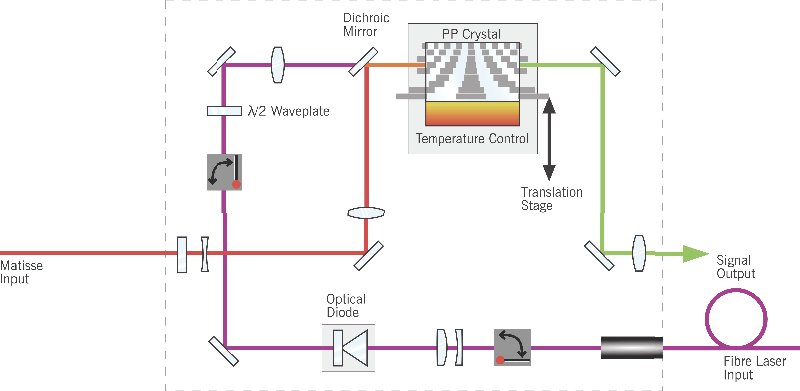
MixTrain 2 optical schematic
The MixTrain utilizes quasi-phase matching in periodically poled crystals for sum- or difference frequency mixing of two cw-lasers. The system uses a motor controlled translation stage for changing the period of the crystal and a temperature stabilized oven capable of heating up to 180°C. All optics for beam shaping, polarization control, beam combination, and beam separation are included. An optical diode isolates the fiber laser input from back reflections from the setup. Periodically poled mixing crystals are mounted in a removable configuration to allow for alternate fiber input wavelengths. The mixing crystals are housed in a temperature stabilized oven with motorized control, providing hands free tuning over >100 nm of the visible spectrum.
Sum Frequency Mixing ~480 to 670 nm
Sum frequency mixing provides visible wavelengths from 480 to 670 nm. Typical tuning curve is shown when sum mixing a 4.5 W Matisse output and 1550 nm single mode fiber laser output with 10 W. When pumped with the Matisse C and the appropriate fiber laser the MixTrain provides hands-free, all solid state output from 422–670 nm for SFM, an attractive and versatile alternative to a CW dye laser.
Difference Frequency Mixing ~1.1 to 4.5 µm
With Difference Frequency Mixing, the output of a ti:sapphire laser is mixed with a single mode fiber laser at 1064 nm, 1550 nm, or 1950 nm. Difference frequency mixing provides near to mid-IR wavelengths. Typical tuning curve is shown when difference mixing a 4.5 W Matisse output and 1550 nm single mode fiber laser output with 10 W. Flexible configuration of mixing and separating optics enables output from 1.1-4.2 μm for DFM, depending on fiber laser input.
Includes All Needed Optics
The MixTrain is equipped with all optics needed for combining input lasers, mixing in periodically poled crystals, and separation of the desired sum (SFM) or difference (DFM) frequency mixing output from the residual input beams. The platform includes a lens to collimate the output, and an isolator to protect the fiber laser from damage due to back reflections. Crystals and optics are easily field exchangeable, providing flexibility for conversion between sum frequency mixing and difference frequency mixing.
Automated Wavelength Setting with Wide Scan Ranges
A motor controlled translation stage and temperature stabilized oven are easily software controlled. Manual adjustments are not required for tuning.
Multiple crystals can be mounted simultaneously for tuning across 100+ nm. Scan ranges without the change of crystal temperature are >20 GHz for visible and >60 GHz for IR tuning.
Compatible Power Sensors
To verify and analyze the output power of your MixTrain laser, we recommend the Ophir 2A-BB-9 (7Z02767) thermal power sensor and Centauri laser power meter. Additional information on this laser measurement equipment can be found on the ophiropt.com website. Other Ophir sensors and meters may also be suitable for the MixTrain, depending on application. Ophir also works with laser system developers to achieve embedded beam diagnostics to monitor system performance as an OEM solution.
Resources
Data Sheets
- MixTrain Datasheet (634.2 kB, PDF)
Literature
- CW Tunable Lasers Brochure (3.8 MB, PDF)
- Ultrafast Lasers Brochure (4.6 MB, PDF)
- Advancing Photonics-Based Quantum Technologies Research (7.3 MB, PDF)
Drawings & CAD
- MixTrain Dimensions (185 kB, PDF)

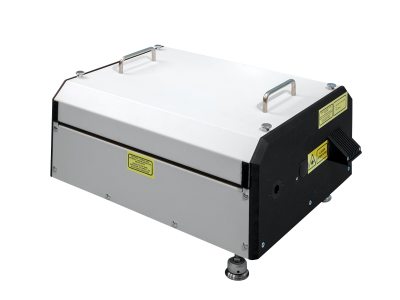
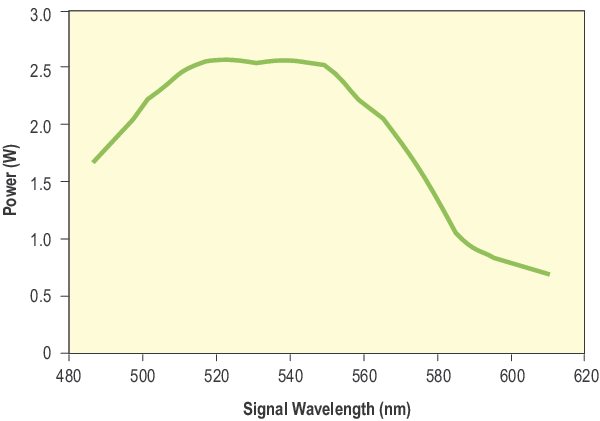
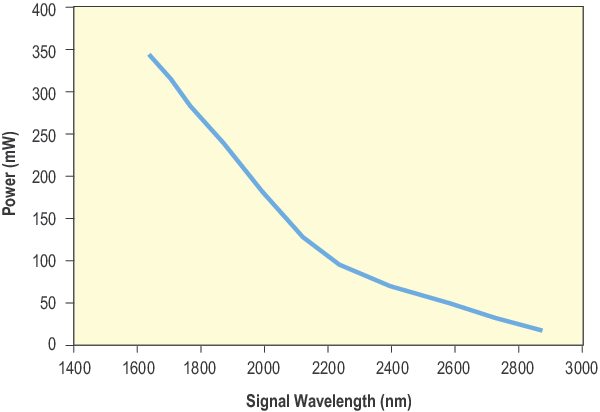
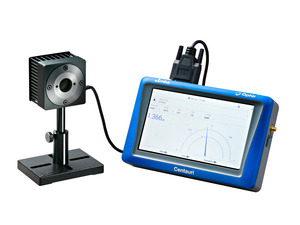
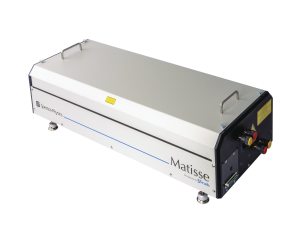
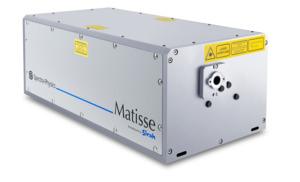
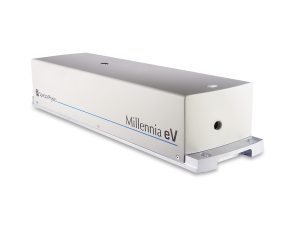
 Ultra-High Velocity
Ultra-High Velocity